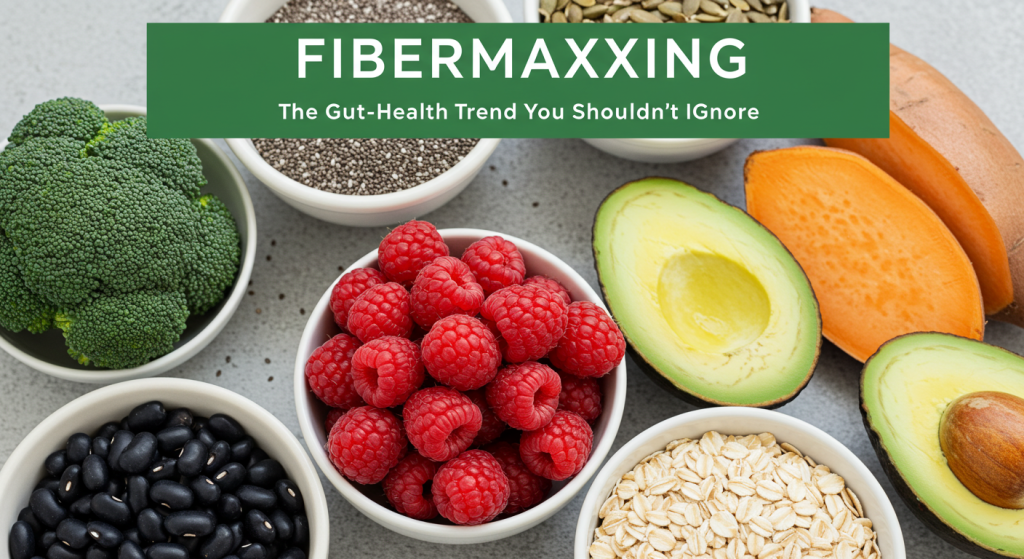Ever noticed the word “fibermaxxing“ pop up on TikTok or wellness blogs? It’s the latest buzzword in gut health—and unlike many fleeting trends, this one has real science behind it. Short for maximizing your daily fiber intake, fibermaxxing aims to boost digestion, stabilize blood sugar, promote satiety, and support overall wellness.
If you think this is just another diet fad, think again. Nutrition experts have been singing fiber’s praises for decades, and now social media has simply given it a catchy name and viral momentum. From Instagram reels showing colorful smoothie bowls loaded with chia seeds to YouTube shorts of meal preppers stacking containers of lentil salads, fibermaxxing has officially moved from dietitian handouts into mainstream pop culture.
Sounds promising—but here’s the catch: Too much, too soon can backfire. That’s why this guide walks you through what fibermaxxing really means, how to do it safely and sustainably, and why health-conscious readers like you should care.
What Is Fibermaxxing?
Fibermaxxing isn’t a medical term—it’s social-media slang for strategically meeting or exceeding your recommended daily fiber intake through whole foods and sometimes supplements.
The idea is simple: instead of accidentally falling short on fiber (like most adults do), you make it a priority in every meal and snack. This could mean adding a spoonful of flax seeds to your yogurt, swapping white bread for whole-grain, or piling your plate with extra vegetables at dinner.
On platforms like TikTok, users share fiber-packed meals—like chia pudding breakfasts, veggie-powered wraps, and bean-based soups—as part of a trend to prioritize fiber for gut health. Many influencers frame it as “feeding your gut bugs,” a fun way to talk about the gut microbiome’s need for prebiotic fibers.
Why Fibermaxxing Matters (Health Benefits)
Here’s why this trend is more than just online hype:
- Improves digestion and gut microbiome – Fiber serves as fuel for beneficial gut bacteria, promoting healthy regularity and helping maintain a balanced gut ecosystem.
- Supports metabolic health – Soluble fiber helps regulate blood sugar and insulin responses, offering support for metabolic balance and potentially lowering the risk of type 2 diabetes.
- Lowers cholesterol & supports heart health – Fiber binds to LDL (“bad”) cholesterol for elimination, reducing cardiovascular risk factors.
- Reduces disease risk – A high-fiber diet is linked to lower risk of colorectal cancer, type 2 diabetes, and heart disease.
- Promotes satiety & weight control – High-fiber foods slow digestion, helping you feel full longer, reducing cravings, and making portion control easier without counting calories.
- Mood and cognitive support – Emerging evidence suggests gut-brain benefits, including improved neurotransmitter balance and mood stability.
Pro Tip: Pair fiber-rich meals with lean proteins and healthy fats for longer-lasting energy and improved nutrient absorption.
The Risks of Going Fibermaxxing-Too-Fast
While fiber is powerful, more isn’t always better—especially if you ramp up intake too quickly:
- Digestive discomfort – Rapid increases can lead to bloating, gas, cramps, or even constipation if not paired with enough fluids.
- Mineral absorption interference – Excessive fiber, especially from supplements, may reduce absorption of iron, calcium, and zinc.
- Unsuitable for some digestive conditions – People with IBS, IBD, SIBO, or other sensitivities may need tailored approaches and should consult a healthcare provider first.
- Supplement misuse – Over-reliance on fiber powders can lead to imbalance; whole food sources are preferable for their vitamin, mineral, and antioxidant content.
Key takeaway: Fibermaxxing should be a slow, intentional process—not an overnight overhaul.
How to Start Fibermaxxing Safely (Step-by-Step)
1. Start Low, Go Slow
Begin with a small increase (e.g., +5 g/day), and ramp up week by week depending on your tolerance. Your digestive system needs time to adapt.
2. Hydrate Generously
Fiber needs water to move through your system—aim for 8+ glasses/day or more if you’re increasing fiber. Without enough fluids, extra fiber can cause constipation.
3. Mix Fiber Types
Include both:
- Soluble fiber (e.g., oats, beans, fruits) – gels in the gut, slows digestion, helps control blood sugar.
- Insoluble fiber (e.g., whole grains, vegetable skins) – adds bulk, supports regular bowel movements.
4. Favor Whole Foods Over Supplements
Prioritize fiber-rich plants; use supplements (e.g., psyllium husk) only if food alone isn’t enough—and consult a professional before starting.
5. Track Your Intake & Response
Use apps or food logs to monitor fiber and symptoms. Pay attention to how your body responds and adjust accordingly.
6. Professional Guidance When Needed
If you have digestive health concerns or nutritional deficiencies, check in with a dietitian or physician before major changes.
Best Foods & Fiber Sources for Fibermaxxing
| Category | Examples & Benefits |
|---|---|
| Legumes | Lentils, beans, chickpeas (≈ 5–8 g per ½ cup)—affordable, protein-rich, versatile |
| Whole Grains | Oats, quinoa, barley, whole-grain pasta & bread—fiber plus vitamins and minerals |
| Fruits | Berries, apples with skin, bananas—provide soluble fiber and antioxidants |
| Vegetables | Leafy greens, broccoli, peas—rich in insoluble fiber and micronutrients |
| Seeds & Nuts | Chia, flax, almonds—add fiber, healthy fats, and texture to meals and snacks |
| Supplements | Psyllium husk, inulin—use sparingly under guidance for topping intake gaps |
Quick meal ideas:
- Breakfast: Overnight oats with chia seeds and berries.
- Lunch: Mixed-bean salad or lentil soup.
- Dinner: Whole-grain pasta with veggies and lentil “meatballs.”
- Snacks: Apple with almonds; hummus with veggies; berries and flax yogurt.
FAQs about Fibermaxxing
1. How much fiber is too much?
Adults generally aim for 25–38 g/day. Going much beyond (e.g., > 70 g/day) may cause discomfort; keep increases gradual.
2. Can fibermaxxing help weight loss?
Yes! Fiber promotes satiety, helps regulate blood sugar, and may reduce cravings—making it supportive of weight control efforts.
3. What about supplements vs whole foods?
Whole-food fiber comes with additional nutrients and microbial support. Supplements can help fill gaps, but should be used judiciously.
4. Are there fibermaxxing pitfalls for sensitive intestines?
Absolutely—those with IBS, IBD, or SIBO may react to sudden increases or certain fibers (especially fermentable types). It’s best to consult your provider.
5. How long until I notice benefits?
Many experience improved digestion, satiety, or blood sugar control within days to a few weeks. Long-term benefits—like reduced disease risk—emerge over months and years.
Pro Tips to Make Fibermaxxing Enjoyable
- Flavor your fiber – Add herbs, spices, or citrus to veggie dishes to make them more appealing.
- Sneak it in – Stir chia seeds into smoothies, add beans to pasta sauce, or snack on air-popped popcorn.
- Batch cook – Prepare high-fiber meals in bulk to save time and ensure consistency.
- Mix textures – Combine crunchy raw vegetables with softer cooked ones to keep meals interesting.
- Experiment with cuisines – Many global diets, like Mediterranean or plant-forward Asian cuisines, are naturally fiber-rich.
Conclusion & Call-to-Action
Fibermaxxing, done thoughtfully, is an accessible, affordable, and evidence-backed way to elevate your gut health, metabolic function, and overall vitality. But remember—balance, hydration, and gradual progress are what make it sustainable.
Your Next Steps:
- Choose one high-fiber meal today (e.g., oatmeal with berries).
- Add +5 g of fiber per week—monitor how you feel.
- Stay hydrated and mix different fiber sources.
- Track your progress and tweak as needed.
- Share your journey or questions in the comments—this community supports real change.
Ready to start fibermaxxing the smart way? Commit to one fiber-rich swap today—and check back to share your wins or ask for tips!

